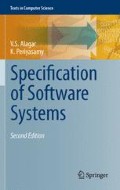Abstract
An automaton is an abstract machine that performs a task according to a specified set of instructions. It captures the behavior of a computer through its ability to read input, perform a sequence of step-by-step operations, and produce an output. Each step in a computation sequence is called a state. Given an input string, the machine reads the first (leftmost) symbol in its initial state and the state of the machine changes. The machine reads the next symbol at the new state and changes its state again. This process continues until the last symbol of the string has been read. The final state is the state reached by the machine after reading the last symbol from the input string. The last state characterizes the input string with respect to the machine. In general, an automaton, by virtue of states, is a useful abstraction for characterizing the behavior of a broad class of software and hardware systems. An automaton itself can be classified based on different perspectives:
-
finite or infinite,
-
deterministic or nondeterministic,
-
accepter or transducer.
Access this chapter
Tax calculation will be finalised at checkout
Purchases are for personal use only
References
Alur R, Dill D (1991) The theory of timed automata. In: de Bakker JW, Huizing C, de Roever WP, Rozenberg G (eds) Real-time: theory in practice. LNCS, vol 600, pp 74–106
Boyer RS, Moore JS (1977) A fast string searching algorithm. Commun ACM 20:762–772
Büchi JR (1989) Finite automata, their algebras and grammars: towards a theory of formal expressions. Springer, New York. Published posthumously
Dima C (2001) Real-time automata. J Autom Lang Comb 6(1):3–23
Hopcroft J, Ullman J (1979) Introduction to automata theory, languages, and computation. Addison Wesley, Reading
Knuth D, Morris JH Jr., Pratt V (1977) Fast pattern matching in strings. SIAM J Comput 6(2):323–350
Martin J (2003) Introduction to languages and the theory of computation, 3rd edn. McGraw-Hill, New York
Mealy GH (1955) A method to synthesizing sequential circuits. Bell Syst Tech J 1045–1079
Moore EF (1956) Gedanken-experiments on sequential machines. Automata studies. Ann Math Stud 34:129–153
Rabin MO (1963) Probabilistic automata. Inf Control 6:230–245
Author information
Authors and Affiliations
Corresponding author
Rights and permissions
Copyright information
© 2011 Springer-Verlag London Limited
About this chapter
Cite this chapter
Alagar, V.S., Periyasamy, K. (2011). Automata. In: Specification of Software Systems. Texts in Computer Science. Springer, London. https://doi.org/10.1007/978-0-85729-277-3_6
Download citation
DOI: https://doi.org/10.1007/978-0-85729-277-3_6
Publisher Name: Springer, London
Print ISBN: 978-0-85729-276-6
Online ISBN: 978-0-85729-277-3
eBook Packages: Computer ScienceComputer Science (R0)

